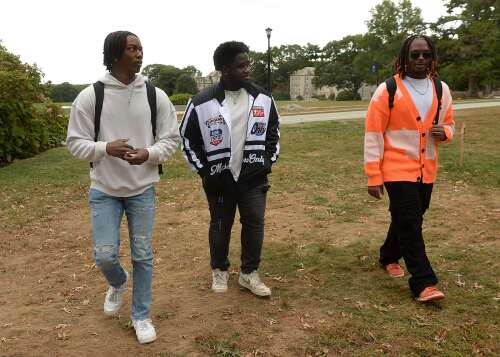New London — Connecticut College saw a substantial rise in its Black and Latino student enrollments for its 2028 graduating class, while the white and Asian-American populations decreased.
Despite a 2023 Supreme Court decision ending race-based admissions nationwide, stating affirmative action was discriminatory against Asian-Americans, Conn College among other selective universities like Princeton University and Yale University saw declines in their Asian enrollment.
The conservative-majority court ruled 6-3, that Harvard University and the University of North Carolina at Chapel Hill engaged in biased admissions standards against Asian-Americans, who scored higher on standardized testing than any other group.
For many colleges, the class of 2028 is the first enrolled without race-conscious admissions in decades. While Conn among others saw an increase in its Black and Latino classes, according to data released by the college, many others like Brown University, Tufts University and Amherst College saw declines.
Black students experienced the steepest declines in enrollment at elite colleges and universities, while white enrollments remained most steady among all groups. Asian-American enrollments varied, according to an analysis of first-year enrollments from several elite colleges.
Aaron Young McKissack, 20, is a junior at Conn College studying education and Africana studies.
Originally from Chicago, McKissack, a Black man, works as a tour guide for the admissions office, previously served as a class president and sits on the executive board for the Men of Color Alliance (MOCA), an affinity group on campus.
“When I first saw the class 2028, I was pretty ecstatic,” said McKissack. ”I was like, ‘Whoa, that’s a lot’“of diversity.
MOCA hosted its first meeting on Sept. 20 and the attendance was the strongest McKissack has seen in his three years at the college.
Now that more students of color are on campus, McKissack hopes younger students’ experience at the predominantly white institution will be less lonely.
“When I first got here, I felt out of place,” he said. “For men of color on this campus right now, a lot of times we are seen as a threat. It seems like (we) don’t belong.”
“You walk around and a white girl will still clutch her purse,” he said.
Jangael Rosales was surprised fewer Asian-American students were enrolled this year. Rosales, 21, an Asian-American student from Chicago studying computer science, says the Asian-American population has strengthened since she first arrived at Conn College.
“When I first got here, there wasn’t an active space for us,” she said. “Even though the statistics show a decline, I’ve seen growth and enthusiasm.”
Rosales was against the court’s affirmative action ban, fearing it would harm Asian Americans rather than help them. With the ban, she hopes students from lower-income backgrounds will be prioritized in college admissions, ensuring greater diversity.
At the University of Connecticut, the share of Asian students in the fall freshman class slightly decreased, while Black, Latino and white enrollment increased.
Mitchell College in New London declined to share its enrollment demographics this year but said in a statement the college, “does not anticipate a change in the racial makeup of our student population.” It added that “41% of students at Mitchell College identify as people of color, and we anticipate that will increase in the coming years as we strive to make college more accessible to all students.”
Even though race-based admissions did not play a role in the school’s admission, Connecticut College’s newest freshman class is one of the most diverse in the college’s history. Among the 458 first-year students, 55 students, or roughly 12%, are Black or African American and 60, or around 13% are Latino American.
White enrollment saw the sharpest decrease this year, falling five percentage points. Despite the decline, white students still comprise 80% of the freshman class. Asian-American enrollment fell nearly three percentage points to 7.5%, compared to last year’s freshman class.
In a statement, Conn College said it underwent an “exhaustive analysis of its policies and procedures to ensure compliance with federal law” following the Supreme Court decision.
“While one year’s worth of data does not constitute a trend, the range of demographic outcomes this fall in first-year classes at colleges and universities nationwide reflects the many factors at play and the difficulty of drawing any broad conclusions,” the college said.
Eddie R. Cole, a professor of education and history at the University of California Los Angeles, says it is too early to understand how affirmative action’s ban will impact college admissions nationwide. In the short term, he says underrepresented students might have greater doubts about mentioning their race when applying to schools.
Cole explained the ban on race-based admissions also allows legislators to push for bans of diversity, equity and inclusion, and race-based scholarships like those enacted in Texas, Missouri and Florida.
“The Supreme Court’s decision was strictly about race in the admissions process, but there has been broad overreach beyond admissions by some state lawmakers since then,” Cole said.
With Black and Latino enrollment seeing sharp increases, students of color on campus are optimistic Conn College is working to make the campus more diverse, despite the ruling from the Supreme Court.
As selective colleges figure out their admissions standards in a post-affirmative action world, Cole says more minority and low-income students will turn to regional colleges and historically Black and Hispanic colleges and universities, absorbing resources if unaddressed.
“That increase has to be paired with addressing the historic underfunding of HBCUs, which do not have the capacity to handle an influx of thousands more applicants than usual. The same is applicable for many regional, predominately white campuses,” he said.
t.wright@theday.com

